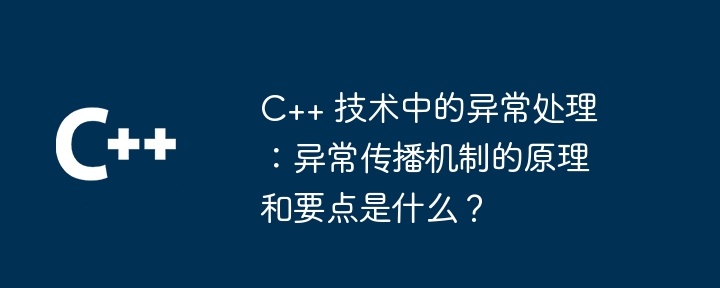Home >Backend Development >C++ >Exception handling in C++ technology: What are the principles and key points of the exception propagation mechanism?
Exception handling in C++ technology: What are the principles and key points of the exception propagation mechanism?
- PHPzOriginal
- 2024-05-09 12:09:01660browse
Exception propagation mechanism: When an exception occurs in a function, it will propagate to the upper function until it is caught or continues to propagate. Key points: 1) Exception throwing is implemented through throw; 2) Catching exceptions uses try-catch blocks; 3) Repropagating exceptions uses rethrow.

C Exception propagation mechanism in exception handling: principles and key points
Exception propagation mechanism
When an exception occurs in a function, it will be passed on to the function that calls the function. This process is called anomaly propagation.
The principle of exception propagation
- When an exception occurs in a function, it will throw an exception object.
- The function that calls this function is responsible for catching the exception or continuing to propagate it to the upper layer.
- During the exception propagation process, each function must decide whether to catch or continue to propagate the exception.
Key points of exception propagation
- try-catch block: Used to catch exceptions. This block should be placed around code segments that may throw exceptions.
- throw: Used to throw an exception object. This statement will terminate the current function and continue to propagate the exception to the upper layer.
- rethrow: Used to re-propagate an exception after catching it. This allows exceptions to continue to be propagated upwards.
Practical case
The following is a simple example showing the exception propagation mechanism:
#include <iostream>
using namespace std;
void f1() throw(int) {
throw 42;
}
void f2() {
try {
f1();
}
catch (int e) {
cout << "Caught an integer exception: " << e << endl;
}
}
int main() {
f2();
return 0;
}In this example:
- Function
f1()Throws aninttype exception. - Function
f2()Use atry-catchblock to catch this exception and print it to standard output. -
main()Function callf2(), if an exception is thrown inf1(), it will bef2()Capture and process.
The above is the detailed content of Exception handling in C++ technology: What are the principles and key points of the exception propagation mechanism?. For more information, please follow other related articles on the PHP Chinese website!

